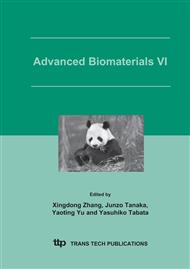p.537
p.541
p.545
p.549
p.553
p.557
p.561
p.565
p.571
In Vitro Degradation Studies of Calcium Polyphosphate Ceramics Prepared by Controlled Degree of Polymerization and Crystallization
Abstract:
Porous calcium polyphosphate(CPP) have been shown to promise for tissue engineered implant application. The process from Ca(H2PO4)2 to CPP, as a polycondensation reaction, has been researched to evaluate the number average degree of polymerization. CPP with different degree of polymerization were prepared by controlling the calcining time. Amorphous and different crystalline CPP were prepared by the quenching from the melt and crystallization of amorphous CPP. Two specimens were soaked into citric acid and tris-buffer solution for 1 to 30 days. The weight loss of CPP with different degree of polymerizations and crystal types are different. With the increasing of degree of polymerization, the weight loss during the degradation is decreasing, contrarily the strength of CPP is increasing. The degradation velocity of amorphous CPP, α-CPP,β-CPP and γ-CPP with the same degree of polymerization decreased in turn at the same period. The full weight loss period of CPP can be changed between 17 days and more than 1 year. The degradation and deposition was faster in the citric acid than the tris-buffer solution.
Info:
Periodical:
Pages:
553-556
Citation:
Online since:
June 2005
Authors:
Price:
Сopyright:
© 2005 Trans Tech Publications Ltd. All Rights Reserved
Share:
Citation:


